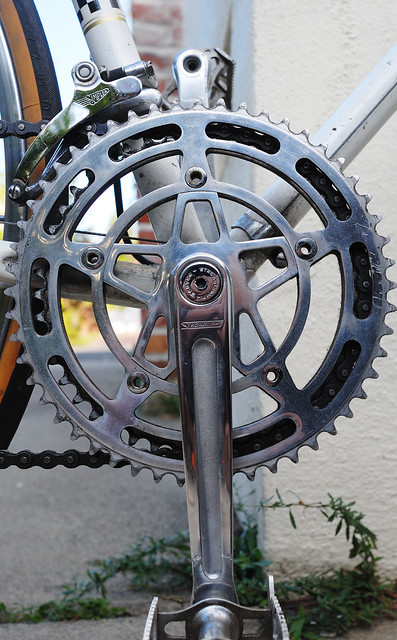Black-anodized components, as I mentioned in
yesterday’s post, have waxed and waned in popularity during (and before) the
four decades I’ve been a cyclist. I hope I did not convey the impression that
all components were black or silver. At
various times during my years on two wheels—and throughout the history of
cycling—bike parts have been anodized in a spectrum of colors.
Today, most of the parts available in a rainbow of
hues are intended for fixed gear or single speed bikes. While cranks, chainrings, pedals, cogs and
even chains are available the Roy G. Biv range for bikes designed for the
velodrome or urban hipsters. But
cranksets with more than one chainring, derailleurs, brakes and other parts
made for road, touring or mountain bikes are usually made in either silver or
black, with the latter shade becoming more dominant as carbon-fiber bikes gain
popularity. One of the few notable
exceptions to the hegemony (or tyranny, depending on how you look at it) of silver
and black in road and off-road bike parts is Velocity rims.
| Weinmann Vainqueur 999 brakes. Red and blue were offered only from 1961 to 1964. |
However, in decades past, parts for road, touring
and sport bikes have been finished in other colors, red and blue being the most
common. Weinmann and Mafac made their
center-pull brakes in those colors for brief periods during the late 1950’s and
early 1960’s. Mafac, in their last years
(the early 1980’s), also made their cantilever brakes in a variety of colors.
| Modolo Professional brake, circa 1983. And you thought white components were sooo 2009? |
| Ofmega Maglia Rosa rear derailleur. You can't make this stuff up! |
The component makers that became most noted for
their color palettes were Italian and offered the greatest variety during from
the late 1970’s until the mid 1980’s.
Perhaps the most prominent of them were Modolo and Ofmega. The former finished their “Professional”
brakes—found on otherwise all-Campagnolo bikes—in red, blue, green, gold and
white, as well as the traditional black or silver. The latter company finished their
derailleurs, which were essentially Campagnolo Records rendered in plastic, in
the rosa hue of the Giro d’Italia
leader’s jersey as well as the jaune of
its Tour de France counterpart, and just about every other color imaginable.
| Colnago C60 with 24 karat gold-plated Campagnolo parts |
Other companies did not offer such a wide range of
tones but nonetheless parted, at least to one degree or another, from the
silver/black binary. I have ridden
gold-anodized Mafac 2002 and Galli brakes; Zeus, Sugino and SunTour also made
derailleurs, cranksets and other parts with gold anodizing. Of course, if really wanted bling, you went for the gold-plated (24 karat) parts Campagnolo briefly made before the price of the
precious metal skyrocketed around 1980.
| Galli rear derailleur in "midnight blue" |
In addition to gold, Galli offered one of the most
distinctive finishes in the history of bicycle componentry: “midnight blue”. It was, of course, darker than most other
blue parts but was more complex and richer than navy or black. In addition to brakes, derailleurs, cranksets,
hubs and other traditional “gruppo” parts, Galli offered rims (made for them by
FIR) and retrofriction shift levers (manufactured by Simplex) in midnight
blue. Galli were even finishing 3TTT
stems, bars and seatposts in their trademark finish. Such an ensemble looked absolutely fabulous
on a white Olmo of that period, but it also looked great on celeste Bianchis
and just about any silver bike.
| Kooka crank, circa 1992 |
Probably the last time components made for bikes
with more than one gear or to be ridden by anyone besides Keirin racers or
hipsters was the early- to mid-1990’s, when it seemed that every
twenty-something in California whose father had a lathe in his garage was
making parts, mainly for mountain bikes, that were lighter and more expensive
than everything else on the market.
Kooka and Topline crankset, which I mentioned in an earlier post, are
examples of that genre. Interestingly,
survivors of that time, like Paul Components and White Industries, are now
making their (admittedly fine) stuff in silver and black. Chris King may be the only exception: His headsets, hubs and other parts are
finished in even more colors than they were two decades ago.
These days, all of my bike components are black or
silver. Part of the reason is that most
of the stuff I use is available only in those colors. But another is that I don’t want parts that
detract from the kinds of finishes I like on my frames.





